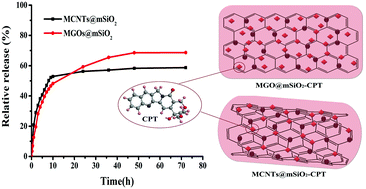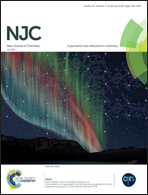Multifunctional carbon nanomateriels for camptothecine low-water soluble anticancer drug delivery†
Abstract
In the past decade, carbon nanomateriels such as CNTs and GO with large surface area have attracted considerable attention for their application in drug delivery and biomedicine. In this work, a multifunctional hybrid nanomaterial of magnetic graphene oxide (GO) and magnetic carbon nanotubes (CNTs) was ensheathed with mesoporous silica, for the loading and delivery of an anticancer drug, camptothecine (CPT). Magnetic nanoparticles (MNPs) were first decorated onto GO and CNTs through a solvothermal method, and then layered with mesoporous silica mSiO2. The structure, morphology and properties of the prepared magnetic nanomaterials were investigated. CPT as an anti-tumor model drug was loaded on the magnetic nanomaterials, and the drug loading capacity of these nanocarriers was as high as 200 mg g−1 and the drug release behavior demonstrated a sustained and pH-responsive behavior. These drug-loaded nanomaterials could be manipulated by an external magnetic stimulation for targeted drug delivery. The MGO@mSiO2–CPT complex showed remarkably high cytotoxicity in HeLa cell lines compared to the pure drug. The results suggested that the prepared nanomaterials showed great potential as an effective multifunctional nanoplatform for magnetic targeting and controlled drug delivery for cancer chemotherapy.



 Please wait while we load your content...
Please wait while we load your content...